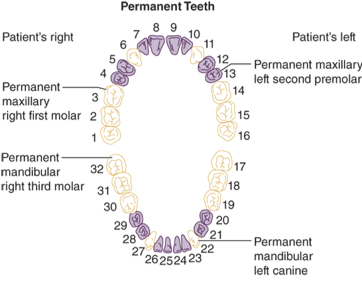Back to Basics: Dental Pain
Dental pain is a common chief complaint in the emergency department, but it can mean many different things. How do we differentiate between them, and what are common treatments?
Let’s start with the basics. Which tooth is it? The average adult has 32 permanent teeth including 12 molars, 8 pre-molars, 8 incisors, and 4 canines. Start off by counting from the upper right posterior tooth, the right first molar which will be tooth #1, until you find the tooth causing dental pain.

Non-traumatic causes of dental pain:
Dental caries (cavities)
- Result from plaque accumulation from bacteria causing a disruption of the tooth’s enamel. When the tooth’s pulp is exposed, this can cause pulpitis or hypersensitivity to cold or sweet foods. Ongoing pulpitis can cause pulp necrosis, which causes more spontaneous, poorly localized pain and can lead to peri-apical infections.
- Treat with pain control and referral to dentist for further management. Usually fillings can be placed for minor dental caries, root canal or extraction needed for irreversible pulpitis.
- Antibiotics are generally not needed, unless there are signs of active infection (ie fever, malaise, lymphadenopathy, swelling, cellulitis) or if immunocompromised
Dental infections & abscesses: many different types based on location and mechanism, here are a few of the most common
- Gingival abscess:a localized swelling that develops at the margin of the gingiva over 24-48 hours and is usually caused by trapped food. To treat it, remove the foreign body from the gingiva and irrigate with sterile saline. These do not usually require I&D
- Pericorionitis: inflamed gum over partially erupted tooth; treat with irrigation, pain control, antibiotics if cellulitis present
- Periodontal abscess: abscess of gums, extending into periodontal pocket often caused by underlying gum disease
- Periapical abscess: forms at the base of the tooth due to bacterial spread from dental caries
- Odontogenic abscesses can spread regionally, cause severe swelling and airway compromise
Traumatic causes of dental pain: fractures, luxation injuries… more on these to come next week!
References:
- Beaudreau RW. Oral and Dental Emergencies. In: Tintinalli JE, Ma O, Yealy DM, Meckler GD, Stapczynski J, Cline DM, Thomas SH. eds. Tintinalli's Emergency Medicine: A Comprehensive Study Guide, 9e
- Fawazi R and Harir EM. The treatment strategy of an oblique complicated crown-root fracture: Case report. Pediatric Dental Care. 2016. June; 1(100).
- Mayersak RJ. Facial trauma. In: Walls RM, Hockberger RS, Gausche-Hill M, Bakes K, Baren JM, Erickson TB, Jagoda AS, Kaji AH, VanRooyen M, Zane RD. eds. Rosen’s Emergency Medicine: Concepts and Clinical Practice,9e
- Vazquez MP, Haddad D, Picard A, Kadlub N. Injuries to the Face, Neck, Mouth, and Scalp.Child Abuse. 2017:189-213. doi:10.1007/978-3-319-65882-7_10.
- Douglass AB, Douglass JM. Common dental emergencies. Am Fam Physician. 2003;67(3):511‐516.
